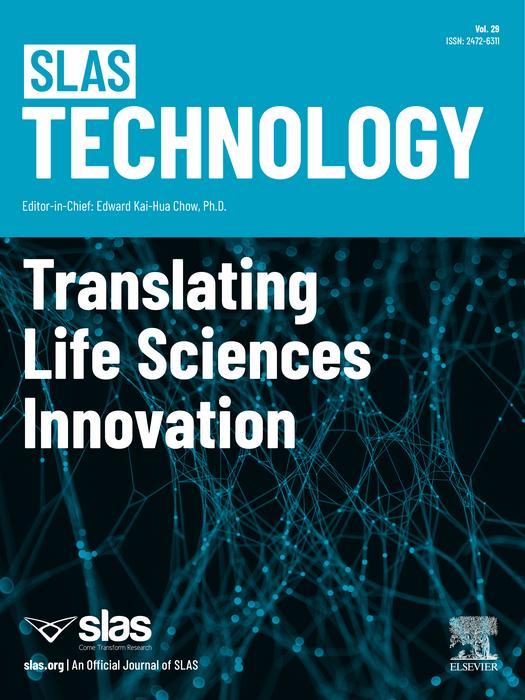Oak Brook, IL – Volume 29, Issue 2 of SLAS Technology, includes three original research articles covering skin cutaneous melanoma, glycan-bead coupling and acoustic ejection mass spectrometry, and eight articles from the Advances in Synthetic Biology Special Issue.

Credit: SLAS Publishing
Oak Brook, IL – Volume 29, Issue 2 of SLAS Technology, includes three original research articles covering skin cutaneous melanoma, glycan-bead coupling and acoustic ejection mass spectrometry, and eight articles from the Advances in Synthetic Biology Special Issue.
Original Research
- Validating core therapeutic targets for osteoporosis treatment based on integrating network pharmacology and informatics
This study recognizes metabolism-related lncRNAs associated with osteoporosis (OP) and constructed a prediction model for OP progression using these lncRNAs. The authors identify central therapeutic targets including CBFB, GLO1, NFKB2 and PIK3CA, as well as core lncRNAs providing insights into potential therapeutic mechanisms and diagnostic references for OP patients. - Parallel purification of microscale libraries via automated solid phase extraction
Presented is a novel parallel purification method using solid phase extraction (SPE) integrated with high-throughput experimentation for drug discovery. This approach enhances the efficiency and sustainability of compound library synthesis by significantly upgrading purity while automating the workflow. - SADXAI: Predicting social anxiety disorder using multiple interpretable artificial intelligence techniques
An investigation into the diagnosis of Social Anxiety Disorder using machine learning techniques based on demographic, emotional and physical symptoms. AdaBoost and logistic regression models achieved the highest accuracy of 88%, with four explainable artificial intelligence techniques used to enhance interpretability. The results suggest the potential utility of this clinical decision-support system in diverse settings like schools, hospitals and workplaces.
Advances in Synthetic Biology Special Issue
- Experimental and biophysical modeling of transcription and translation dynamics in bacterial- and mammalian-based cell-free expression systems
The authors introduce a biophysical model for simulating transcription and translation dynamics in bacterial- and mammalian-based cell-free expression (CFE) systems. Developed using ordinary differential equations and adjusted with experimental data, the model reveals kinetic differences in gene circuits between E. coli and HeLa-based CFE systems. This model and accompanying experimental data offer insights valuable for researchers in genetic engineering and CFE bio-manufacturing, enabling quantitative genomic and proteomic studies. - Recent advances of droplet-based microfluidics for engineering artificial cells
The article reviews recent advances in droplet-based microfluidic techniques for fabricating vesicles and artificial cells. It highlights their potential applications in studying gene expression dynamics, cell-cell communication and mechanobiology. These techniques offer high-throughput, simple control and flexibility, addressing the need for robust and stable artificial cells in various fields, such as synthetic biology and drug development. - Development of mechanosensitive synthetic cells for biomedical applications
The importance of mechanosensitive (MS) ion channels in cells is discussed. It proposes using MS synthetic cells, which mimic cell behavior, for medical applications. Three concepts are outlined for utilizing ultrasound, shear stress and compressive stress to trigger drug release from these synthetic cells, offering potential avenues for disease treatments. - TidyTron: Reducing lab waste using validated wash-and-reuse protocols for common plasticware in Opentrons OT-2 lab robots
This article addresses the challenge of plastic waste generated by biotechnology labs. It proposes TidyTron, a library of protocols for automating cleaning single-use plastic labware with liquid handling robots. Through rigorous testing, the protocols aim to minimize time and cost while ensuring effective decontamination, facilitating the safe reuse of plasticware and promoting sustainability in biological research. - Multiplex digital microfluidics using serial controls and its applications in glucose sensing
The authors present a platform that enables the simultaneous control of multiple printed circuit board (PCB)-based digital microfluidics (DMF) plates, addressing the limitation of throughput in current PCB-based DMF systems. The platform shows potential for low-cost, high-throughput point-of-care testing suitable for resource-limited settings. - State-of-the-art in engineering small molecule biosensors and their applications in metabolic engineering
This article reviews recent advancements in genetically encoded biosensors, mainly focusing on small molecule biosensors, for understanding chemical-biological interactions and accelerating metabolic engineering. It highlights the significance of protein-based biosensors utilizing less common signaling mechanisms like protein stability and induced degradation, suggesting their potential for engineering eukaryotic and slower-growing prokaryotic systems. - Employing synthetic biology to expand antibiotic discovery
The article discusses the growing threat of antimicrobial-resistant (AMR) bacterial pathogens and the limitations of current therapeutic methods, prompting research into new approaches for identifying small molecules to combat AMR infections. It emphasizes the potential of synthetic biology in predicting and inducing novel antibiotics by characterizing native regulation of antibiotic biosynthetic gene clusters and modifying non-ribosomal peptide synthase and polyketide synthase pathways to enhance natural product production. - Engineering transcriptional regulation for cell-based therapies
This article explores the potential of transmembrane receptor-based platforms to regulate gene transcription in response to user-defined inputs, aiming to enhance therapeutic cellular functions. By examining current engineering approaches, the review discusses the implications for various applications, such as cancer treatment and regenerative medicine, while proposing strategies to improve the control further and expand the capabilities of gene regulation in cellular therapies.
This issue of SLAS Technology is available at
*****
SLAS Technology reveals how scientists adapt technological advancements for life sciences exploration and experimentation in biomedical research and development. The journal emphasizes scientific and technical advances that enable and improve:
- Life sciences research and development
- Drug delivery
- Diagnostics
- Biomedical and molecular imaging
- Personalized and precision medicine
SLAS (Society for Laboratory Automation and Screening) is an international professional society of academic, industry and government life sciences researchers and the developers and providers of laboratory automation technology. The SLAS mission is to bring together researchers in academia, industry and government to advance life sciences discovery and technology via education, knowledge exchange and global community building.
SLAS Technology: Translating Life Sciences Innovation, 2022 Impact Factor 2.7. Editor-in-Chief Edward Kai-Hua Chow, Ph.D., National University of Singapore (Singapore
###
Journal
SLAS TECHNOLOGY
Article Publication Date
1-Apr-2024



